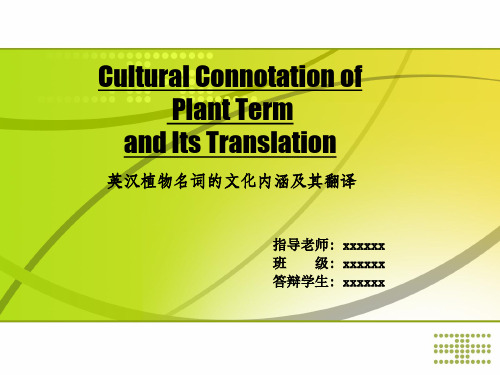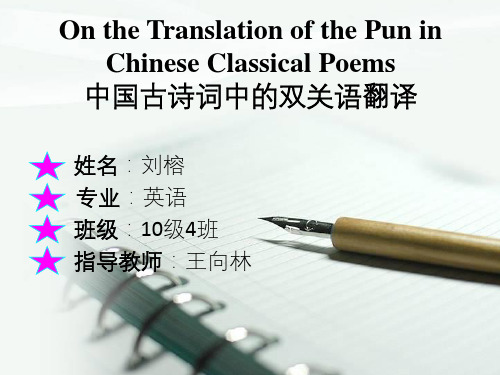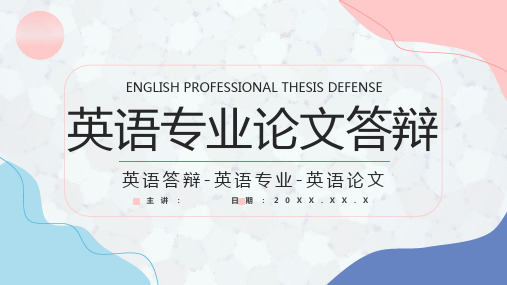英文论文答辩PPT模板(完美版)
合集下载
英语专业毕业论文答辩PPT模板

课题研究现状 Research Status
In recent years, much attention has been paid to Jack London's ecological thought embodied in this famous novel, which attempts to raise it to a higher level of human consciousness. The analysis of ecological consciousness and Eco-criticism in recent studies have begun to provide insight into the unbalanced relationships between human and human, human and animals as well as human and nature around the world, which gives people a warning for the repercussions of the abuse and destruction of nature and calls for the harmonious coexistence between human and nature.
02 研究目的和意义
Purpose and Significance of the Research
研究目的和意义 Purpose and Significance of the Research
The purpose of this thesis is to analyze the novel The Call of the Wild from the perspective of Ecology. In order to make all the people around the world live peacefully and never forget the revenge of nature, this paper is completed. The analysis of ecological consciousness and Ecocriticism in this paper reveals the unbalanced relationships between human and human, human and animals as well as human and nature around the world, which gives people a warning for the repercussions of the abuse and destruction of nature.
英语论文答辩ppt范文

ADD YOUR TITLE
CLICK HERE TO ADD YOUR TITLE
01
02
ADD YOUR TITLE
Add your text here and write down your ideas here
03
ADD YOUR TITLE
Add your text here and write down your ideas here
CLICK HERE TO ADD YOUR TITLE
输入你的要点一 1 输入你的要点二 2
输入你的要点三 3
YOUR KEY WORDS
4 输入你的要点四 5 输入你的要点五
6 输入你的要点六
CLICK HERE TO ADD YOUR TITLE
Add your text here and write down your ideas here Add your text here and write down your ideas here
04
ADD YOUR TITLE
Add your text here and write down your ideas here
ADD YOUR TITLE
Add your text here and write down your ideas here
CLICK HERE TO ADD YOUR TITLE
Add your text here and write down your ideas here Add your text here and write down your ideas here
Add your text here and write down your ideas here Add your text here and write down your ideas here
英文论文答辩PPT模板(完美版)

back
Plant Terms
Lily of the valley (铃兰)
Carrot (胡萝卜)
In Chinese signifies “pure friendship”
of great nutritional value
In English
a symbol of "death“
has been considered to be " a reward or benefit that is very attractive but difficult to obtain
back
Ways on How to Translate Plant Terms
Literal translation method (include literal
translation, notation or interpretation)
Translation method of replacement
Then three basic ways of translation are put forward.
Key Words: plant terms, cultural connotation, comparative study, translation
Outline
1. Introduction 2. The Cause of Diverse Cultural Connotations of Words
culturalconnotationofplanttermanditstranslation英汉植物名词的文化内涵及其翻译英汉植物名词的文化内涵及其翻译指导老师
Cultural Connotation of Plant Term
Plant Terms
Lily of the valley (铃兰)
Carrot (胡萝卜)
In Chinese signifies “pure friendship”
of great nutritional value
In English
a symbol of "death“
has been considered to be " a reward or benefit that is very attractive but difficult to obtain
back
Ways on How to Translate Plant Terms
Literal translation method (include literal
translation, notation or interpretation)
Translation method of replacement
Then three basic ways of translation are put forward.
Key Words: plant terms, cultural connotation, comparative study, translation
Outline
1. Introduction 2. The Cause of Diverse Cultural Connotations of Words
culturalconnotationofplanttermanditstranslation英汉植物名词的文化内涵及其翻译英汉植物名词的文化内涵及其翻译指导老师
Cultural Connotation of Plant Term
英语专业论文答辩PPT课件

第8页/共13页
Contents
4.New Historicism in A Christmas Carols 4.1 Different periods of Scrooge 4.2 Marginalized Characters 4.2.1 Dead Marley 4.2.2 Poor Bob
Huaying and Lecturer. Li Liantao provide me with valuable advice, and
give me related resources on my thesis. Both of them suggest me to
find a related theory to support this thesis, which help me a lot in
Abstract
A Christmas Carols is one of the classic Christmas novels of Charles Dickens, having been loved by people and being passed on the Christmas custom from then on. The novel describes the whole process the protagonist as a mean and unkind miser turns into a generous and kind person, visited by three spirits respectively from the past, the present and the future. Combined with the miserable childhood experience in the Victorian, the thesis also analyses the influence of the three spirits’ visiting and reflects the character of capitalist loving money to death and miserable fate of the poor by new historicism in historicity of texts and textuality of history. This novel not only tells the exploitations which capitalist brings to the poor, but also reveals the truth that human being good by nature. People should be encouraged to get rid of all kinds of temptation and being warm-hearted to help others, which makes us live in the harmonious society.
Contents
4.New Historicism in A Christmas Carols 4.1 Different periods of Scrooge 4.2 Marginalized Characters 4.2.1 Dead Marley 4.2.2 Poor Bob
Huaying and Lecturer. Li Liantao provide me with valuable advice, and
give me related resources on my thesis. Both of them suggest me to
find a related theory to support this thesis, which help me a lot in
Abstract
A Christmas Carols is one of the classic Christmas novels of Charles Dickens, having been loved by people and being passed on the Christmas custom from then on. The novel describes the whole process the protagonist as a mean and unkind miser turns into a generous and kind person, visited by three spirits respectively from the past, the present and the future. Combined with the miserable childhood experience in the Victorian, the thesis also analyses the influence of the three spirits’ visiting and reflects the character of capitalist loving money to death and miserable fate of the poor by new historicism in historicity of texts and textuality of history. This novel not only tells the exploitations which capitalist brings to the poor, but also reveals the truth that human being good by nature. People should be encouraged to get rid of all kinds of temptation and being warm-hearted to help others, which makes us live in the harmonious society.
适合英语专业毕业答辩会ppt大气风格模板

限写入的学术意义无限写入的。
学术意义\学术意义\学术意义\学术意义\学术意义\ 学术意义\学术意义\学术意义\学术意义\学术意义\ 学术意义\学术意义\学术意义\学术意义\学术意义\ 学术意义\学术意义\学术意义\
经济意义/经济意义/经济意义/经济意义/经济意义/ 经济意义/经济意义/经济意义/经济意义/经济意义/ 经济意义/经济意义/经济意义/经济意义/经济意义/ 经济意义/经济意义/经济意义/经济意义/
黎曼假设
论文具体内容的你论文具体内容的你论文具体内容的你 论文具体内容的你论文具体内容的你论文具体内 容的你论文具体内容的你论文具体内容的小。论 文具体内容的你论文具体内容的你论文具体内容 的你论文具体内容的你论文具体内容的你论文具 体内容的你论文具体内容的你论文具体内容的小 。t. In nec lacus laoreet orci varius imperdiet sit amet 论文具体内容的你论文具体内容的你论文具体内容的你 in augue. 论文具体内容的你论文具体内容的你论文具体内 容的你论文具体内容的你论文具体内容的小。论 文具体内容的你论文具体内容的你论文具体内容 的你论文具体内容的你论文具体内容的你论文具 体内容的你论文具体内容的你论文具体内容的小 。t. In nec lacus laoreet orci varius imperdiet sit amet 论文具体内容的你论文具体内容的你论文具体内容的 in augue. 你论文具体内容的你论文具体内容的你论文具体 内容的你论文具体内容的你论文具体内容的小。 论文具体内容的你论文具体内容的你论文具体内 容的你论文具体内容的你论文具体内容的你论文 具体内容的你论文具体内容的你论文具体内容的 小。t. In nec lacus laoreet orci varius imperdiet sit amet in augue.
经典英文大学生毕业论文答辩PPT

Company Logo
Diagram
PPTS
Title
Add your text
ThemeGallery
is a Design Digital Content & Contents mall developed by Guild Design Inc.
ThemeGallery
is a Design Digital Content & Contents mall developed by Guild Design Inc.
Company Logo
Cycle Diagram
PPTS
Add Your Text
Text
Text
Text
Cycle name
Text Text
Company Logo
Diagram
PPTS
Text Add Your Title Text
Text •Text •Text •Text •Text
Company
LOGO
PowerPoint Template
PPTS
Contents
PPTS
Click to add Title
Click to add Title
Click to add Title
Click to add Title
Click to add Title
Company Logo
Hot Tip
Company Logo
Table
PPTS
Title Title O
Title O
Title O
Title O
Title O
Title
Title
英语专业毕业论文答辩ppt(终)

•
Year after year never growing old;
•
but mother, unless you give your
daughter away
•
How can you ever hold a grandson in
your arms?
h
9
分析:
第一行中的“枣”与“早”谐音。作者提醒母 亲及早让女儿出嫁。树不知老,可人的美妙 青春容易消逝。这儿,我们只能译出枣子的 “枣”,不可译出及早的“早”。因为“早”与上下 文不合。
On the Translation of the Pun in Chinese Classical Poems
中国古诗词中的双关语翻译
姓名:刘榕 : 专业:英语
班级:10级4班 指导教师:王向林
h
1
目录
• 选题意义 • 研究内容和目标 • 研究过程 • 论文框架 • 翻译策略和实例 • 研究结果
h
6
论文框架
1 引文
1
2 文献综述 3 双关语的定义和分类
4 中国古诗中双关语的翻译策略
5 结论
hLeabharlann 7中国古诗中双关语的翻译策略
译出表面意义 选择一种意义 采用其他词格 注释法
h
8
翻译实例
• 译出表面意义
《折杨柳枝歌》: 门前一棵枣,岁岁不知老。 阿婆不嫁女,哪得孙儿抱?
• 译文:Before the gate stands the jujube tree,
种文化的差异,英汉两种语言不同,更由于诗歌的特殊形式,
要译出原作的双关,确实是极其困难的,常常是不可能的。
我们应根据具体情况,采取相应的办法,尽量展现原作的巧
英文论文答辩PPT模板(完美版) 1

Mixed methods research
This approach combines quantitative and qualitative methods to gain a more comprehensive understanding of research questions
Sample and Data Collection
04
Research results
Overview of Research Findings
01 The research question and its significance
02 The objectives and hypotheses of the study
03
A brief overview of the research methods and procedures
Techniques used to gather information from participants or observations, such as surveys, interviews, focus groups, observations, and documents
Sampling strategies
Ensure that all charts are clear, consistent, and easy to understand
Provide a brief caption or legend for each chart to explain its purpose and content clearly
Research Purpose and Significance
State the main purpose of your research and its significance in the field
This approach combines quantitative and qualitative methods to gain a more comprehensive understanding of research questions
Sample and Data Collection
04
Research results
Overview of Research Findings
01 The research question and its significance
02 The objectives and hypotheses of the study
03
A brief overview of the research methods and procedures
Techniques used to gather information from participants or observations, such as surveys, interviews, focus groups, observations, and documents
Sampling strategies
Ensure that all charts are clear, consistent, and easy to understand
Provide a brief caption or legend for each chart to explain its purpose and content clearly
Research Purpose and Significance
State the main purpose of your research and its significance in the field
英语专业毕业论文答辩PPT模板

RESEARCH
添加标题
请您单击此处添加合适文字加 以说明,可调剂文字大小或者 色彩等属性。
添加标题
请您单击此处添加合适文字加 以说明,可调剂文字大小或者 色彩等属性。
添加标题
请您单击此处添加合适文字 加以说明,可调剂文字大小 或者色彩等属性。
RESEARCH
输入标题
您的内容打在这里,或者通 过复制您的文本后
输入标题
您的内容打在这里,或者通 过复制您的文本后
输入标题
您的内容打在这里,或者通 过复制您的文本后
输入标题
您的内容打在这里,或者通 过复制的内容打在这里,或者通 过复制您的文本后
输入标题
您的内容打在这里,或者通 过复制您的文本后
输入标题
您的内容打在这里,或者通 过复制您的文本后
主讲:
日期:20XX.XX.X
INTRODUCE
输入标题
您的内容打在这里,或者通过复制您的文本后, 在此框中挑选粘贴,并挑选只保存文字。
输入标题
您的内容打在这里,或者通过复制您的文本后, 在此框中挑选粘贴,并挑选只保存文字。
INTRODUCE
输入标题
01
您的内容打在这里,或者通过复制您的文本后,在此框
中挑选粘贴,并挑选只保存文字。
输入标题
您的内容打在这里,或者通 过复制您的文本后您的内容 打在这里,或者通过复制您 的文本后
输入标题
您的内容打在这里,或者通 过复制您的文本后您的内容 打在这里,或者通过复制您 的文本后
ENGLISH PROFESSIONAL THESIS DEFENSE
英语专业论文答辩
英语答辩-英语专业-英语论文
You can also format the appropriate text
蓝色商务风英语专业论文答辩研究过程及成果PPT模板课件

Background of the Paper (论文背景)
Please enter your text on there (请输入相应的文字信息) Please enter your text on there (请输入相应的文字信息)
Please enter your text on there (请输入相应的文字信息) Please enter your text on there (请输入相应的文字信息)
调查对象
1 2
调查方法
收集到数据
3 4
数据分析
2.1 Objects of Investigation (调查对象)
2.2 The Tools of Investigation (调查方法)
2.3 The Collection of the Data (收集到数据)
2.4 Data Analysis (数据分析)
Background of the Paper (论文背景)
2.3 The collection of the data(收集到的数据)
01 02 03 04
Please enter your text on there (请输入相应的文字信息)
Please enter your text on there (请输入相应的文字信息)
Put the text here as you need (在此输入文字信息)
Put the text here as you need (在此输入文字信息)
Put the text here as you need Put the text here as you Put the text here as you need
英语专业答辩ppt课件

Introduction
1.Backgruond and Research Status 2.Purpose and significance 3.Framework of the Paper
没有明确的价值取向和人生目标,实 现自我 人生价 值就无 从谈起 。人生 价值就 是人生 目标, 就是人 生责任 。每承 担一次 责任
The time and some resources are limited,such as unavailable vebsite and foreign literature about Dove advertising language and Speech Act Theory.
没有明确的价值取向和人生目标,实 现自我 人生价 值就无 从谈起 。人生 价值就 是人生 目标, 就是人 生责任 。每承 担一次 责任
Language Functions of Dove Advertising Language
没有明确的价值取向和人生目标,实 现自我 人生价 值就无 从谈起 。人生 价值就 是人生 目标, 就是人 生责任 。每承 担一次 责任
Conclusion
Pragmatic Rhetoric
没有明确的价值取向和人生目标,实 现自我 人生价 值就无 从谈起 。人生 价值就 是人生 目标, 就是人 生责任 。每承 担一次 责任
Contents
IInnttroduuccttiioonn
LLiitteerratuurreeRReevviieeww
Analysis of Dove Advertising Language Based on Speech
Act Theory Conclusion
没有明确的价值取向和人生目标,实 现自我 人生价 值就无 从谈起 。人生 价值就 是人生 目标, 就是人 生责任 。每承 担一次 责任
1.Backgruond and Research Status 2.Purpose and significance 3.Framework of the Paper
没有明确的价值取向和人生目标,实 现自我 人生价 值就无 从谈起 。人生 价值就 是人生 目标, 就是人 生责任 。每承 担一次 责任
The time and some resources are limited,such as unavailable vebsite and foreign literature about Dove advertising language and Speech Act Theory.
没有明确的价值取向和人生目标,实 现自我 人生价 值就无 从谈起 。人生 价值就 是人生 目标, 就是人 生责任 。每承 担一次 责任
Language Functions of Dove Advertising Language
没有明确的价值取向和人生目标,实 现自我 人生价 值就无 从谈起 。人生 价值就 是人生 目标, 就是人 生责任 。每承 担一次 责任
Conclusion
Pragmatic Rhetoric
没有明确的价值取向和人生目标,实 现自我 人生价 值就无 从谈起 。人生 价值就 是人生 目标, 就是人 生责任 。每承 担一次 责任
Contents
IInnttroduuccttiioonn
LLiitteerratuurreeRReevviieeww
Analysis of Dove Advertising Language Based on Speech
Act Theory Conclusion
没有明确的价值取向和人生目标,实 现自我 人生价 值就无 从谈起 。人生 价值就 是人生 目标, 就是人 生责任 。每承 担一次 责任
英语专业毕业论文答辩PPT模板精选全文

Put Title here(输入标题)
Enter text (输入具体内容)Enter text (输入具体内容) Enter text (输入具体内容)Enter text (输入具体内容)
第三章
Your Paper Content (你的论文内容)
2024/8/19
2024/8/19
Enter Your Title here(输入标题)
Please enter your text on there (请输入相应的文字信息)
Please enter your text on there (请输入相应的文字信息)
Please enter your text on there (请输入相应的文字信息)
2.4 Data analysis(数据分析)
2024/8/19
2024/8/19
Enter Your Title here(输入标题)
Put details in textbook(在文本框内输入详细信息) Put details in textbook(在文本框内输入详细信息)
Put details in textbook(在文本框内输入详细信息) Put details in textbook(在文本框内输入详细信息) .Put details in textbook(在文本框内输入详细信息) .Put details in textbook(在文本框内输入详细信息) .
2024/8/19
Listening and Speaking(听说 )
The Key Word (关键词)
Testing(测试)
。
Reading(读)
2024/8/19
Writing(写)
Enter text (输入具体内容)Enter text (输入具体内容) Enter text (输入具体内容)Enter text (输入具体内容)
第三章
Your Paper Content (你的论文内容)
2024/8/19
2024/8/19
Enter Your Title here(输入标题)
Please enter your text on there (请输入相应的文字信息)
Please enter your text on there (请输入相应的文字信息)
Please enter your text on there (请输入相应的文字信息)
2.4 Data analysis(数据分析)
2024/8/19
2024/8/19
Enter Your Title here(输入标题)
Put details in textbook(在文本框内输入详细信息) Put details in textbook(在文本框内输入详细信息)
Put details in textbook(在文本框内输入详细信息) Put details in textbook(在文本框内输入详细信息) .Put details in textbook(在文本框内输入详细信息) .Put details in textbook(在文本框内输入详细信息) .
2024/8/19
Listening and Speaking(听说 )
The Key Word (关键词)
Testing(测试)
。
Reading(读)
2024/8/19
Writing(写)
毕业答辩 论文设计PPTGRADUATION THESIS REPLY DESIGN PPTPlea

50%
Contents 02
Choice 2
There are many variations of passages
There are many variations of passages of Lorem Ipsum available, but the majority have suffered alteration
点击添加相关标题文字
ADD RELATED TITLE WORDS
Sample text
Sample text
Sample text
01
02
03
点击添加相关标题文字
ADD RELATED TITLE WORDS
点击添加相关标题文字
ADD RELATED TITLE WORDS
点击添加相关标题文字
25%
Contents 03
Choice 3
Theቤተ መጻሕፍቲ ባይዱe are many variations of passages
点击添加相关标题文字
ADD RELATED TITLE WORDS
点击添加相关标题文字
ADD RELATED TITLE WORDS
Title Goes HereThere are many variations of passages of lorem ipsum available, but the majority have suffered
Title Goes HereThere are many variations of passages of lorem ipsum available, but the majority have suffered
- 1、下载文档前请自行甄别文档内容的完整性,平台不提供额外的编辑、内容补充、找答案等附加服务。
- 2、"仅部分预览"的文档,不可在线预览部分如存在完整性等问题,可反馈申请退款(可完整预览的文档不适用该条件!)。
- 3、如文档侵犯您的权益,请联系客服反馈,我们会尽快为您处理(人工客服工作时间:9:00-18:30)。
With lexical gaps
Olive branch(橄榄枝): Symbolizes peace and hope in both Chinese and English.
Laurel tree(月桂树): Symbolizes honor and prominence in both Chinese and English.
Rose(玫瑰): Symbolizes love in both Chinese and English.
Grass-root(草根): Symbolizes common and ordinary things in both Chinese and English.
Ears of wheat(耳小麦): Symbolizes the same kind of spirit, that is modest, showing no pride.
Then three basic ways of translation are put forward.
Key Words: plant terms, cultural connotation, comparative study, translation
Outline
1. Introduction 2. The Cause of Diverse Cultural Connotations of Words
We have just probed into the cultural connotation of plant terms and some methods on how to translate them.
Only careful study of the plant terms in different languages and diverse cultural backgrounds on their differences about the figurative meanings, can the translator effectively deliver the real hidden. There is still a lot of work to do and we should spare no effort to make a further study of plant terms.
2.1 The relationship between culture and language 2.2 Gaps of lexical meaning and its cause 2.3 Lexical association of different cultural connotation of words 2.4 Comparative cultural studies on translation 3. Major Types of English and Chinese Plant Terms Containing Cultural Connotations 3.1 Plant terms with similar cultural connotation 3.2 Plant terms with different cultural connotation 3.3 Gaps of lexical plant terms 3.4 Peculiarity of plant terms 4. Proverbs Containing Plant Terms 4.1 Semantic duality of plant terms 4.2 Semantic duality of proverbs containing plant terms 5. Ways on How to Translate Plant Terms 5.1 Literal translation method (include literal translation, notation or interpretation) 5.2 Translation method of replacement 5.3 Free translation 6. Conclusion
back
Ways on How to Translate Plant Terms
Literal translation method (include literal
translation, notation or interpretation)
Translation method of replacement
The purpose of this thesis is to help translators obtain the equivalent of the maximum effect in translation.
The Cause of Diverse Cultural Connotations of Words
Free translation
Conclusion
From the above discussion one may easily find that the same plant term in the two different languages often comes along with different associative meanings.
back
Plant Terms
Lily of the valley (铃兰)
Carrot (胡萝卜)
In Chinese signifies “pure friendship”
of great nutritional value
In English
a symbol of "death“
has been considered to be " a reward or benefit that is very attractive but difficult to obtain
Cultural Connotation of Plant Term
and Its Translation
英汉植物名词的文化内涵及其翻译
指导老师: xxxxxx 班 级: xxxxxx 答辩学生: xxxxxx
Abstract
This thesis attempts to make a comparative study of plant terms in English and Chinese in order to translate them more accurately.
Acknowledgements
Many thanks are due to my supervisor, Associate Prof. xxx for his careful reading the whole manuscript and his patient correction.
Also, I owe a special debt to Ms. xxx, whose constructive suggestions helped me shape the form and content of this paper.
Maple trees (枫树)
contains more than "feeling of anxiety"
symbolizes “happy, strange and beautiful"
back
Chinese peony (牡丹) and western rose(玫瑰) Chinese bean(大豆) and western apple(苹果) Chinese white poplar(白杨树) and western oak(橡树)
Significance of Writing This Thesis
Any language and its corresponding culture are interdependent.
This thesis discusses about cognitive meanings of Chinese and English Plant terms and their translation in more detailed comparative study. Thus in intercultural communication, one can effectively avoid mistakes and improve interpersonal skills.
Geography Religious belief Common habits and interests
Major Types of English and Chinese Plant Terms
With similar cultural connotations
Plant terms
Байду номын сангаас
With different cultural connotations
I am especially grateful for Prof. xxx, my fellow classmates and teachers of Foreign Language School for their generous help, whose influence will be farreaching in my life.
When proceeding with the study, some basic concepts, such as culture and language, are firstly defined.
In the middle part of this thesis, the plant terms are divided into three basic groups according to their cognitive meanings in Chinese and English respectively.
